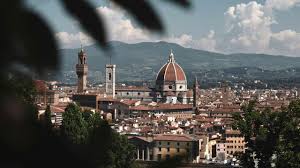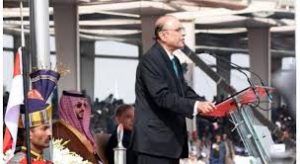Off season Italy: Florence comes alive in fall

Noo Saro-Wiwa
Florence: This is part of Off Season Italy, a collection of guides highlighting the year-round appeal of Italy’s most popular destinations, courtesy of our favorite local tastemakers. Read more here.
Marina Serena Cacciapuoti is the co-founder and creative director of Italy Segreta, an online magazine that explores the hidden corners of the country and provides an insider’s perspective on Italian culture, travel, food, and lifestyle. Marina grew up between Rome and Florence before moving to New York in 2014, where she worked as a photo editor and designer at Vice, Condé Nast Traveler, and Hearst magazines. In 2020, she returned to Italy and launched Italia Segreta with her twin brother, Cesare. Here, she tells us the best things to do in Florence once the crowds have disappeared.

Is there a time to visit Florence when there are fewer travelers around? Yes! November—just in time for olio nuovo (the new olive oil harvest)—through March. Avoid the week of Pitti Uomo (men’s fashion week); it’s usually held during the first week of January when Florence is overbooked and filled with peacocking fashionistas. On weekends, the streets are still crowded, but it’s mostly Italians who are visiting or coming into town. However, more and more tourists are starting to visit during the off season.
The scent of burning firewood wafting in from the surrounding countryside. There’s no humidity, no mosquitoes, and no crowds—however, we’re beginning to see a tourist influx even during this “off season.”
Florentine cuisine is best enjoyed in the colder months.
Think hearty soups like ribollita (stale bread and veggies that are double-boiled, double-cooked, and double-flavored); acquacotta maremmana (vegetable soup); and la farinata di cavolo nero (kale and polenta soup). Dishes such as trippa (tripe), fegatini (liver paté) and fagioli (vegetable pasta soup) are hearty and rich. Winter is also wild game season—hunting is technically permitted from the end of September until the end of January, making it the perfect time to enjoy pappardelle al cinghiale (wild boar), and attend the food fair Sagra del Cinghiale e del Tortello, which typically occurs around the end of February or early March. Regional food festivals are where you can get a feel for the comradery of small Tuscan towns and savor some exceptional food.
I also love the weekend walks outside the city center when the air is cold, and you feel the literal and metaphorical warmth of a countryside restaurant upon entering it. The winter light is clearer, starker, and crisper. Maybe we appreciate it more just because the days are shorter and the weather colder, but the sunsets really do turn the sky the brightest pink. On some days, the visibility is so great that the Ponte Vecchio—seen from the Ponte della Trinita—looks like a painting with the hills extending infinitely behind it.
Tell me all about your favorite local spot to eat. It’s rowdy, it’s rustic, it’s warm, it’s cozy, it’s real. It showcases one of my favorite aspects of Italy—a small space that brings people of all backgrounds together, from the old man who has never left Florence to the construction worker, entrepreneur, and aristocrat, all sitting at one communal table for the joy of enjoying a great meal. The menu changes seasonally, but Bettola is best known for the penne alla Bettola. I love the fried artichoke and red wine beef stew, as well as the roast pork loin. Followed, of course, by the torta di mele (apple cake).
What’s the best thing to eat when you really need to warm up? There’s nothing better than a bowl of ribollita to warm up on cold winter evenings. Even better if it’s at Trattoria Ruggero, an old-school, all-wooden restaurant just beyond the city walls past Porta Romana.
What are the parts of town we need to know about? Neighborhoods like Sant’Ambrogio are where you get to breathe real Florentine life: locals meet for sandwiches, coffee, or simply hang out between the daily fresh food market. Cibreo Caffé and Tripperia Pollini Sant’Ambrogio are here, as well as Piazza di Sant Ambrogio. At night, the street (Borgo La Croce) fills with young people having drinks outside of bars such as Articolo and Enoteca Sosta dei Papi.
Or head to the Porta Romana area. There are small independent shops like Bronzetto (artisanal lamps) and Vignoli (the best butchers), institutions like Bar Dell’Angolo where young Florentines hang out at night, and people of all ages congregate during the day.
Paint a picture of your perfect November day in Florence. I’ll have an early breakfast at Caffè Libertà or at Pasticceria Gualtieri, famous for its Iris cake which is naturally gluten-free and made with almond flour. On my way back from Gualtieri, I’ll stop at the Mercato di Santo Spirito for produce and at S.forno for sourdough bread. Then I’ll have a game of tennis at Circolo del Tennis Firenze—I love Circolo in any season.
Lunch has to be in the countryside, either at Ristorante Tullio in Montebeni (order the ravioli alla mugellana, which is potato-stuffed, or the fried bistecca Florentine-style steak). Or I’ll eat at Da Delfina in Artimino. For something more casual, I’ll go to Fattoria Di Maiano for farm-to-table dishes and a stroll across the grounds—it’s especially great if you’re with kids. From Tullio, I like to walk back down to the city center via the San Domenico neighborhood. There are a few shortcuts to avoid the main roads but you’ll have to join me on that walk to know the way.
For aperitivo I’ll have a glass of wine, usually natural, at Enoteca Spontanea or Enoteca Bellini. Dinner is at Trattoria Cammillo—an institution that stays solid despite its fame. Owners Chiara and Massimo are there every day. A must-order is pollo al curry, la ceciata (thin chickpea pie), frittata di carciofi (artichoke frittata), and torta di pere (pear cake).
I love to end the day with a movie at Giunti Odeon, a recently renovated cinema that dates back to 1922 and plays films in their original language. It doubles as a bookstore, too.
Is there one can’t-miss November activity you look forward to? I love cycling to the countryside on a mission—in other words, getting lunch. Also, sitting in front of a wood-burning fire with a glass of wine. Or taking long walks through Florence, from Porta Romana up to the Viale in time for sunset views at San Miniato al Monte, and then down the steep street to San Niccolo for a glass of wine and cheese at Formaggioteca Terroir—all thankfully without the crowds or stifling heat.





